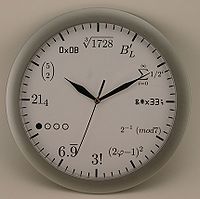Course:MATH103/Archive/2010-2011/207/Lectures/Lecture09
| Faculty of Science Department of Mathematics | |
|---|---|

| |
| Course Pages | |
| Course Policies | |
| Math Solvers | |
| Exams | |
| Quizzes | |
| Assignments | |
| Lectures | |
Lecture 9
Readings For This Lecture
- Chapter 5, pages 81 to 90 (up to subsection 5.5)
Summary
Group 3: Add a summary of the lecture in this space. Include examples, discussion, and links to external sources, if desired.
Exercises
1. Five beads are distributed along a thin 1 dimensional wire. Their masses and positions are: . Find the total mass and the center of mass of this discrete mass distribution.
Solution:
Total Mass = Sum of
= 5+2+1+2+10
= 20
Center of mass = (1/M)[Sum of ]
= (1/20)(80)
= 4
2. Suppose that the function represents the density of a bar for . Explain the distinction between:
- the average density of the bar,
- the mass of the bar, , and
- the center of mass (or centroid) of the bar, .
3. The density of a bar is given by . Find the total mass of the bar. Also find the average density, and the center of mass. Where should you cut this bar in order to obtain two bars of the same mass? What fraction of the mass is found between 0 and 1/2?
4. The density of a bar is given by . Find the center of mass of the bar. What happens to the center of mass if and is very large? What happens to the center of mass if and is very large?
5. A chamber with a square cross-section is 90% filled with water. Describe the shape that the center of mass traces inside the square cross-section as the chamber is rotated.




![{\displaystyle x\in [a,b]}](https://wiki.ubc.ca/api/rest_v1/media/math/render/svg/026357b404ee584c475579fb2302a4e9881b8cce)








